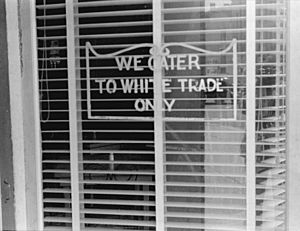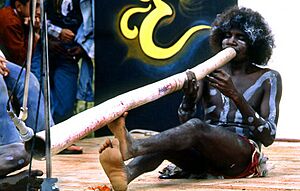Racism facts for kids
Racism is a harmful belief that one group of people is better than another, simply because of their race or ethnicity. It can lead to unfair treatment, strong dislike, or even violence against others.
Throughout history, racism has caused many terrible things, like wars and slavery. For example, during the Holocaust, Nazis in Germany believed some races did not deserve to live. Because of these racist ideas, they killed millions of people. Leaders often used racism to make their cruel actions seem acceptable.
Contents
Understanding Race and Ethnicity
People often group themselves by race or ethnicity. An ethnic group might share common ancestors, speak the same language, have a similar culture, or live in the same areas.
However, scientists say that from a biological point of view, humans are very similar. Our DNA is almost identical, no matter our race. Evidence from genetics and archaeology shows that all humans came from the same early groups in East Africa and the Middle East. This means we all share a common origin. Sometimes, when people who have historically had more power face unfair treatment, it is called reverse racism.
Examples of Racism in History
Here are some examples of how racism has shown up in different parts of the world:
- The Jim Crow laws in the United States (around 1890 to 1960) kept black and white people separate and unequal.
- The Armenian Genocide in the Ottoman Empire involved the killing of many Armenians.
- The Nuremberg Laws and The Holocaust in Nazi Germany (1935-1945) led to the mass murder of Jews and other groups.
- The Apartheid laws in South Africa (after 1948) created a system of strict racial separation and discrimination.
- The White Australia policy in Australia limited who could immigrate to the country.
- The Ku Klux Klan in the U.S. is a group that has attacked and discriminated against African Americans, Catholics, Jews, and immigrants.
Racist Beliefs and Systems
European 'Aryanism'
In the late 1700s, some Europeans started using the term Aryan to describe themselves, especially those who spoke Indo-European languages. They believed they were superior to other cultures. By the late 19th century, some Europeans, particularly in Germany, Austria, and Hungary, began to claim that only Nordic people were "pure" Aryans.
These beliefs that one's own race was better than others led to terrible events like African slavery, Apartheid, the Jim Crow Laws, Nazism, and Japanese imperialism.
Colonialism
When Europeans came to America to set up colonies, they caused the deaths of many Native Americans. In Australia, European settlers also killed large numbers of Aborigines. As empires grew, many other native tribes in places like Canada, New Zealand, China, Pakistan, Bangladesh, and India suffered greatly.
Japan also believed its culture was better than the cultures of the Chinese and Koreans in their colonies.
Racism in the UK and France
In the UK, Ireland, and France, racism often targeted Jews, Roma, and other minority groups like the French Basques.
After many countries gained independence in the 1950s, people migrated to the UK and France but faced discrimination. Some British cafes and hotels would not serve Caribbean guests. In France, some Arabs felt unwelcome. Events like September 11, 2001, increased fears about Islam and Arabs in these countries. Racist political parties, like the UK's British National Party and National Front, used these fears to gain support.
Nazism
Nazi Germany used false scientific ideas about race to justify their cruel policies. They promoted the idea of a "Greater Germany" and the "Nordic race" as superior. The Nazis wrongly blamed Jewish people for Germany's defeat in World War I and the Great Depression. The Nazis and their allies, like Hungary, committed genocide against the Jews during The Holocaust in World War II.
The Nazis and Romania's Iron Guard also persecuted the Roma, whom they considered an inferior race. The Porajmos is the name for the Nazis' attempt to wipe out the Roma people.
During World War II, the Nazis also killed many other groups they disliked, including Slavs and people with different political views or lifestyles.
Fascist Italy
Fascist leader Benito Mussolini in Italy also held racist views. He disliked Slavs and Roma, considering them less intelligent and undeserving of basic rights. Italy, like Germany, Austria, and Hungary, believed its own people were superior.
Racism in Romania
The Iron Guard was a fascist political group in Romania from 1927 to 1941. They strongly disliked and spoke out against both Jewish people and the Roma.
Racism in America

American racism has been a big problem since before the country was founded. European settlers treated Native Americans unfairly.
Millions of Africans were captured and forced into slavery by Europeans and Arabs. Many African-American people and others call this period "The Black Holocaust."
Later, Mexican, Chinese, Japanese, and Irish immigrants faced difficulties in America during the 1800s. Black people suffered under the Jim Crow laws, which lasted until the mid-1960s and the Voting Rights Act of 1965.
Racism in the United Kingdom
In the United Kingdom, most people are white. However, there are also significant Asian and Black populations. A poll in 2013 showed that some young British people did not trust Muslims.
Racism in South Africa
South African Apartheid laws were a system that took away many rights from non-white people, starting in 1948. Even though there were more black people in the country, these laws forced them to carry special papers or get permission to live and work in certain areas. White people made it illegal for people of different races to marry. Black people were even banned from voting for a time. Nelson Mandela became South Africa's first black president in 1994, and he helped end apartheid.
Today, some white people in South Africa feel they face racism. For example, former black President Zuma publicly sang a song that some interpreted as "Kill the White [Farmer]."
Japan's Imperial Rule Assistance Association
During World War II, Japanese Prime Minister Fumimaro Konoe took control of important industries, the news media, and labor unions to prepare for war with China. Japan wanted more land, minerals, and colonies. They took over Korea and Manchuria and invaded China. The Japanese believed the Chinese, Koreans, and Europeans were inferior races and that their lands and belongings should be taken.
A Changing World
After many people learned about The Holocaust and with worldwide efforts against racism, old ideas about race slowly began to change. The civil rights movement worked to free people of African origin from racist rule in South Africa and the southern USA. Black people in South Africa were finally allowed to vote after a 50-year ban.
In some cases in the United States, efforts like Affirmative action have tried to help minority groups, but some people feel this has led to "reverse racism," where minorities are favored over others.
Related pages
Images for kids
-
An early use of the word racism by Richard Henry Pratt in 1902: "Association of races and classes is necessary to destroy racism and classism."
-
African-American university student Vivian Malone entering the University of Alabama in the U.S. to register for classes as one of the first African-American students to attend the institution. Until 1963, the university was racially segregated and African-American students were not allowed to attend.
-
In 1899, Uncle Sam (a personification of the United States) balances his new possessions which are depicted as savage children. The figures are Puerto Rico, Hawaii, Cuba, Philippines and "Ladrones" (the Mariana Islands).
-
A rally against school integration in Little Rock, Arkansas, 1959
-
A sign on a racially segregated beach during the Apartheid era in South Africa, stating that the area is for the "sole use of members of the white race group"
-
A 1917 anti-conscription propaganda leaflet imploring voters to "keep Australia white." A horde of Asians bearing a dragon flag is shown to the north.
-
The Book of Genesis's biblical curse on Canaan, which was often misinterpreted as a curse on his father Ham, was used to justify slavery in 19th century America.
-
One in a series of posters attacking Radical Republicans on the issue of black suffrage, issued during the Pennsylvania gubernatorial election of 1866
-
Eichmann's list of the Jewish population in Europe, drafted for the Wannsee Conference, held to ensure the cooperation of various levels of the Nazi government in the Final Solution
-
A drinking fountain from the mid-20th century labelled "Colored" with an African-American man drinking
-
On September 12, 2011, Julius Malema, the youth leader of South Africa's ruling ANC, was found guilty of hate speech for singing "Shoot the Boer" at a number of public events.
-
The burnt out remains of Govinda's Indian Restaurant in Fiji, May 2000
-
Madison Grant's map, from 1916, charting the "present distribution of European races," with the Nordics in red, the Alpines in green, and the Mediterraneans in yellow
-
Separate "white" and "colored" entrances to a café in North Carolina, 1940
-
1935 Chart from Nazi Germany used to explain the Nuremberg Laws, defining which Germans were to be considered Jews and stripped of their citizenship. Germans with three or more Jewish grandparents were defined as Jews, Germans with one or two Jewish grandparents were deemed Mischling (mixed-blood).
-
19th century political cartoon: Uncle Sam kicks out the Chinaman, referring to the Chinese Exclusion Act
See also
 In Spanish: Racismo para niños
In Spanish: Racismo para niños

























